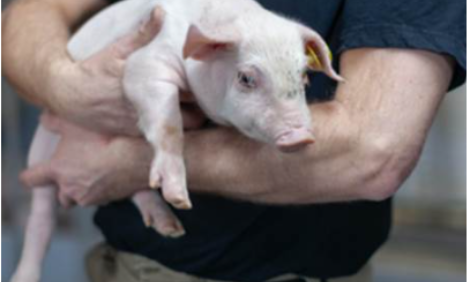



Manipulable Materials for Pigs: Environment Enrichment Tools
The UK Red Tractor Assurance Scheme standards for manipulable material have been amended and come into force on 1 April 2010.Key Changes to the Standards
- Chains alone are not acceptable
- Tyres are not acceptable as some may contain wire which could hurt the pigs
- Objects must be shown to be of interest to the pigs – i.e. not fouled
- Objects must be within the pigs’ reach
Solid Floor Accommodation
Straw offers a number of benefits. It is a manipulable and rootable material and also provides thermal insulation and physical cushioning. In solid floor systems, straw can be provided simply as bedding. Other materials that can be provided alongside straw include hay, wood, sawdust, mushroom compost, peat or a mixture of such which does not adversely affect the health of the animals. Alternatively it can be placed in dispensers/racks, bundles or compressed blocks or 'logs'.
Slatted and Part-Slatted Accommodation
As straw is not a practical option for fully-slatted systems, producers must provide other enrichment toys or materials.
Options for Enrichment
- Pigs respond to novelty and get bored after a while with the same stimuli, therefore different enrichment toys should be rotated to maintain novelty. The BPEX KT team trialled hanging BiteRites and fixed Funbar stations on a number of units across England: both toys encouraged interaction by the pigs and the BiteRites received a higher level of general interest than the Funbar stations.
- Paper sacks and other disposable paper or cardboard materials thrown into grower/finisher pens can be an effective way to occupy pigs. The novelty and effectiveness of these can wear off quickly but paper and cardboard materials can be added from time to time to supplement other more permanent toys, particularly to distract pigs if a tail–biting outbreak has just started or is suspected. Other toys can be provided alongside, such as balls, traffic cones and vegetables, e.g. swedes.
- Chains which include other objects, such as wood or alkathene pipe, can be just as effective, are acceptable and can make use of existing enrichment.
- Hard objects alone do not constitute full enrichment – pigs should also be provided with something soft and malleable/destroyable.
Below are some simple criteria to think about when choosing the best enrichment objects for pigs: the six Ss.
| SAFE No tyres with wire No poisonous wood or wood that may have been preserved No staples or fixings in wood No materials that may be toxic to pigs |
 |
| SANITARY Materials should not be fouled |
 |
| SUSPENDED Provides extended novelty factor, avoids fouling and allows more pigs to gain access to the toy if it suspended in a central position |
 |
| SOFT For the pigs to slowly destroy the object it must be malleable: this adds to the novelty factor |
 |
| SIMPLE Anything too complex can cause frustration and could actually lead to vice A number of simple items is better than one complex one, allowing more pigs to gain access at one time |
 |
| SITE Do not site toys over lying, drinking or feeding areas Dunging areas provide the optimum position Switch sites regularly to help maintain novelty |
 |
Enrichment is just one aspect of a pig’s environment and it is important to get other aspects right too, including ventilation, nutrition, health, water provision and stocking density. All will contribute to improved production and reduced risk of vice.
February 2012








